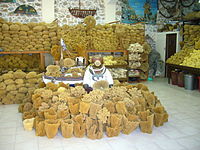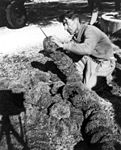Sponge diving

The sponge diving is the oldest known form of diving . It has served to preserve natural sponges for human consumption for at least 6,500 years . Due to today's industrial production of sponges made of viscose , sponge diving has lost its importance and is often only used for tourism purposes.
background
Consisting of calcium carbonate or silica existing sclerits of most sponge species make it rough for most applications. In the past, only the common bath sponge ( Spongia officinalis ) and the horse sponge ( Hippospongia equina ) of the Mediterranean were used as bath sponges . Since the middle of the 19th century , the Caribbean species Spongia barbara (English yellow sponge), Spongia graminea (grass sponge and "glove sponge") and Hippospongia lachne (sheepswool sponge) as well as Hippospongia gossypina (velvet sponge) and the reef sponges Spongia pertusa and Spongia tubulifera were added.
It is not known exactly when the sponge became an article of use. In ancient Greek writings, Plato and Homer mentioned the sponge as an object that was used for bathing. Through trade, Europeans also used soft sponges for many purposes, including padding for helmets, portable drinking utensils, and water filters. Until the invention of the synthetic sponge, they were used for cleaning tools, for applying paints and ceramic glazes, but also as a contraceptive . However, in the mid-20th century, overfishing meant that both the sponges and the industry were on the verge of extinction.
Most objects with a sponge-like structure are nowadays made fully synthetic, which is primarily due to the lower costs.
history
Archaeological finds prove that as early as 4,500 BC Apnea divers in East Asia, India and the Arabian Sea dived for pearls, mother-of-pearl, corals and sponges. In Europe there were first signs of professional diving from around 2,500 BC. BC when Greek sponge divers began to harvest the sponges in large quantities.
Mediterranean Sea
In Greece in particular , sponge diving became very important. This is not only due to the general occurrence of suitable sponges, but also to the geographic conditions there: on the island of Kalymnos, for example, only 18% of the steep volcanic land could be cultivated, so that the most important professions were trade, boat building and sponge diving. This was perhaps the oldest trade on the island. Sponge diving benefited the social and economic development of the island, with apnea diving being used to “harvest” the sponges. Kalymnos was the most important center of sponge production in the Aegean and even today this traditional profession can be seen in three local museums , along with appropriate exhibitions and other local folklore .
The crew went to the Mediterranean in a small boat and used a cylindrical object with a glass bottom to search the sea floor for sponges. If one was found, a diver would go overboard to get it. Apnea was mostly dived naked and with the help of a 15 kilogram scandalopetras, a rounded stone tied to the ship with a rope, which enabled a quick dive to the bottom. The diver then cut the sponge off the bottom and placed it in a special net. Depth and dive time were therefore dependent on the diver's lung capacity. They often reached a depth of about 30 meters for up to five minutes.
Where it was possible, such as B. at Nauplia , the sponges were loosened by means of an iron attached to a long rod. The bath sponges that were brought up were immediately freed from the slime, the sarcode , by washing with water , cleaned and then dried. Fraudulently, they could still be rubbed with fine sand in order to increase their weight, which then had to be washed out again at the entry points.
Caribbean
The ideal growth conditions in the warm, shallow waters of the Bahamas , protected by reefs , made it possible to “harvest” sponges over a large area. Their extraction began in the 1830s, and from 1841 the export of so-called Bahama sponges became big business. In 1890, sponges had become the Bahamas' most important export. Not quite as important was sponge diving in the Florida Keys , often operated by Greek immigrants.
Sponge divers around 1900 in Tarpon Springs , Florida
Sponge divers underwater, 1946 in Florida (Photo: Hamilton Wright)
Individual evidence
- ↑ § 1802 of Title 16 (Conservation of Nature) of the US Code. The Glove Sponge ( Spongia cheiris ) listed there is a synonym of S. graminea according to the World Porifera Database .
- ^ FAO Fisheries department: Sponges: World Production and Markets
- ↑ bath sponges . In: Merck's Warenlexikon . 3rd ed. 1884 ff., P. 28 f.
- ^ Colman Barry: Upon these rocks . St. John's Abbey Press, Collegeville 1973. ISBN 0-8146-0812-4 . P.56.
- ↑ Stephen Frinck, William J. Harrigan: Florida Keys - Diving Guide. Jahr Verlag, Hamburg 1997, ISBN 3-86132-245-5 .



